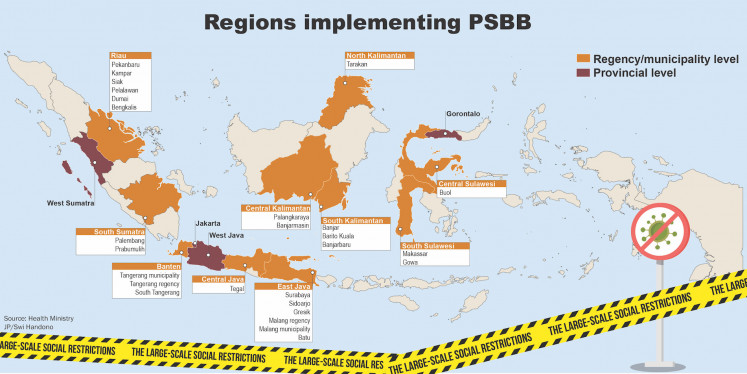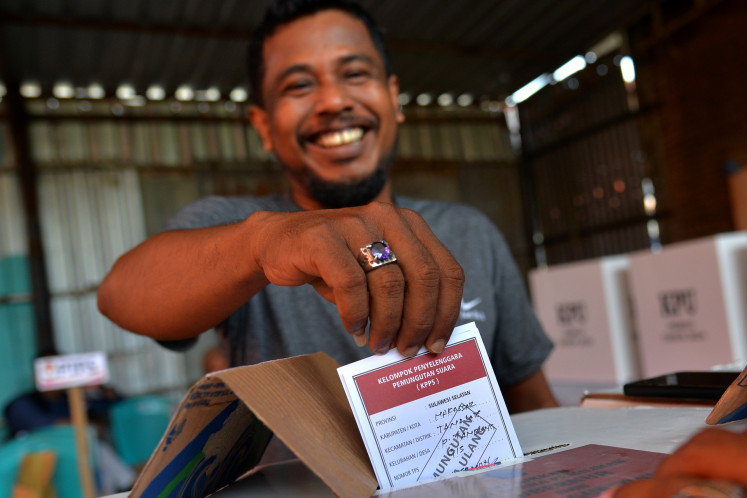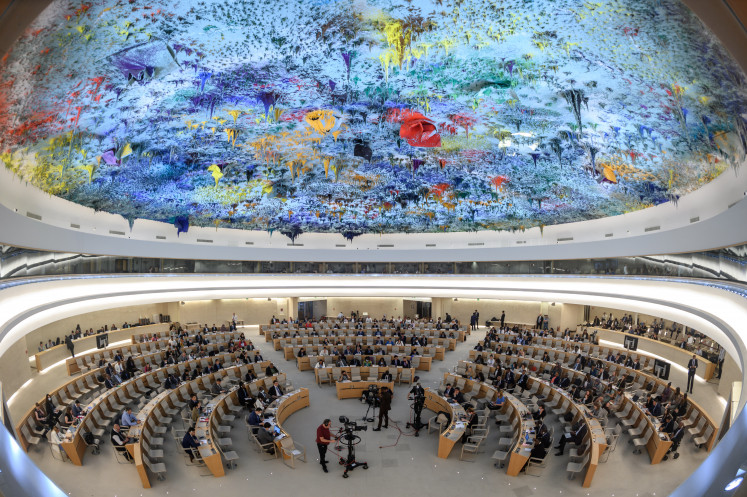Popular Reads
Top Results
Can't find what you're looking for?
View all search resultsPopular Reads
Top Results
Can't find what you're looking for?
View all search results50 days of Indonesia’s partial lockdown. Is it enough for the ‘new normal’?
He said irregular epidemiological patterns as shown during the PSBB were caused by factors such as gaps in incubation period, lack of testing capacity and case-reporting delays, which meant they could not be relied upon as consideration for policy making.
Change text size
Gift Premium Articles
to Anyone
O
n April 3, Indonesia released two regulations, a government regulation and a Health Ministry regulation, to pave the way for large-scale social restrictions (PSBB), the country’s equivalent to partial lockdown.
A week later, Jakarta became the first region to implement the partial lockdown to contain the spread of COVID-19. Jakarta Governor Anies Baswedan has extended the PSBB twice, with the latest slated to end on June 4.
After Jakarta, other regions followed. Three other regions implementing the PSBB at provincial level are West Java, Gorontalo and West Sumatra. Aside from 58 regencies and municipalities within the four provinces, only 27 other regencies and municipalities have applied the partial lockdown even though as of Tuesday, the virus had spread to 406 regencies and municipalities in all 34 provinces.
As of May 28, four out of 27 regencies and municipalities had decided not to continue the PSBB: Gowa and Makassar in South Sulawesi; Tegal, Central Java; and Palangkaraya, Central Kalimantan.
(JP/Swi Handono)The partial lockdown requires offices, schools, places of worship and public spaces to close. Local administrations imposing the PSBB can limit transportation capacity within a region but are not given authority to close inter-regional transportation services.
Approaching Ramadan and Idul Fitri, inter-regional travel was restricted under a nationwide mudik (exodus) ban and a Transportation Ministry regulation, with exceptions for travelers on essential business. Anies has also recently required travelers entering or leaving Greater Jakarta to obtain permits.
Security personnel patrol the streets, but lax enforcement and policy inconsistencies have created rampant violations, from mass gatherings and accidental buildups of passengers at transportation nodes to operating nonessential businesses and widespread mudik participation, with most getting away with light punishments.
President Joko “Jokowi” Widodo repeatedly instructed citizens to be disciplined but his administration, weighed under the burden of sluggish economic growth, layoffs and rising levels of poverty, has issued regulations that could defeat the purpose of strict social distancing, starting with easing transportation restrictions early this month.
This week, while the majority of affected regions had not applied the PSBB and some of those that have implemented the restrictions deciding not to extend them, President Jokowi jumped to adapting the protocols of a so-called “new normal”.
Do the PSBB work?
Despite the consistently low testing rates, the number of new confirmed cases has continued to grow, reaching a total of 24,538 cases, 1,496 deaths and 6,240 recoveries as of Thursday, when 687 new cases were recorded.
The Health Ministry has confirmed fluctuating numbers of new cases daily, with several record highs of new cases and jumps recorded in the past two weeks, despite the government’s occasional claim that the curve has flattened.
After Jakarta enacted the PSBB in the first period, the rolling seven-day average of new cases, which is the daily average of the last seven days and is considered more accurate by scientists than daily cases, still continued to rise and reached its peak on April 17. During that time, mobility was high because many residents went on mudik trips.
<
As the PSBB were extended on April 22 and the government started to ban the mudik two days later, the capital did see a decrease in the average number of new cases. Conversely, when the government reopened passenger travel on May 6, the numbers went up.
Although the relation between the intensity of restrictions applied and the new cases growing seemed to make sense to a degree in Jakarta, this was not the case in West Java and East Java where the link between the two seemed highly irregular.
After Jakarta’s neighboring cities of Bogor, Depok and Bekasi in West Java imposed the PSBB on April 15 and Greater Bandung on April 22, the rolling seven-day average of new cases remained stable. A week after the mudik ban, however, the trend changed, with frequent ups and downs recorded.
In East Java, a province that has not applied province-wide PSBB, the figure continued to rise despite the mudik ban and the PSBB in place in Greater Surabaya and Greater Malang beginning on April 28. On May 21, while the country confirmed a dramatic increase of 973 cases, East Java bore about a half of these and became the country’s new epicenter of the coronavirus.
Most confirmed cases in East Java were reported in the capital Surabaya where poor compliance with social distancing has been noticed. The East Java administration admitted there was a testing backlog as a result of a lack of testing capacity.
Padjadjaran University epidemiologist Panji Fortuna Hadisoemarto said that it was not easy to answer whether the PSBB worked or not using limited case data. He believed, however, that restrictions had become ineffective since Ramadan and Idul Fitri when data showed greater people’s mobility.
He said irregular epidemiological patterns as shown during the PSBB were caused by factors such as gaps in incubation period, lack of testing capacity and case-reporting delays, which meant they could not be relied upon as consideration for policy making.
“We could have actually interpreted the unconfirmed data, mortality data of PDP [patients under surveillance] and ODP [people under monitoring], routine surveys of influenza-like diseases and pneumonia as sources of information for making decisions as well,” Panji told The Jakarta Post on Wednesday.
The number of people undertaking COVID-19 tests has remained very low, at 188,302 as of Tuesday. Jokowi targeted 10,000 coronavirus tests per day in April, but government data show that the highest number of people being tested was 8,595 on May 22. An average of 4,800 people have been tested daily in the past few weeks.
Many suspected cases have died either before having been tested or before receiving their medical results, and were buried under COVID-19 protocols. Funeral statistics in Jakarta have increased significantly, to an extent that Anies described as “extremely disturbing”.
As of May 27, COVID-19 watchdogs have recorded more than 4,600 fatalities among suspected COVID-19 cases in only 19 provinces, based on information collected from provinces, regencies and municipalities. The Health Ministry has refused to include deaths of probable cases in the cumulative COVID-19 death toll as suggested.
New normal may be ‘too soon’
Despite the government’s repeated claims that it has not agreed to any relaxation of the PSBB and will not start doing so anytime soon, it has rushed to the scenario of a new normal, calling on citizens to “coexist” with the virus.
The World Health Organization (WHO) has said that countries taking steps to ease restrictions and transition toward a new normal must make sure COVID-19 transmission is controlled and that communities have a voice and are engaged in the transition.
A Health Ministry decree on new normal guidelines issued over the weekend regulates new heath protocols both during the PSBB and after the PSBB. The government also introduced a new term: reproduction rate, which is an indication of the rate of the virus spread. If the number is below 1.0, it means restrictions can be lifted, scientists have agreed. The Indonesian government claims that Jakarta is among the regions that already have a reproduction rate below 1.0.
Concerns have mounted against the measures, with many insisting that the government should base its policymaking on field implementation and data rather than economic interests to make sure that everyone is ready and safe.
Foundation of the Indonesian Legal Aid Institute (YLBHI) chairwoman Asfinawati regretted that while the government had never imposed a total lockdown, it now considered easing the partial restrictions that had not been implemented optimally.
“The new normal has been brought to Indonesia without a proper context. The country is determined in the narrative of following other countries but it has never implemented the same [restrictions] as others in the first place,” Asfinawati told the Post on Tuesday.
She said that the new normal might aggravate Indonesia’s efforts to combat COVID-19 because on the one hand it must tighten its guard to cover a wider breach of violations, while on the other hand it must carry out more tests and tracking given the chances of wider public contact.
An epidemiologist from the University of Indonesia, Pandu Riono, said with the low testing capacity, the data set as indicators to determine the new normal could also be irrelevant, especially for small regions.
“The data on daily cases are not enough and they are not perfect. The data collection, for example, is late and the reports of lab results come out after five to seven days for cases that might have occurred two weeks previously,” Pandu said.
After the new normal announcement on Tuesday, Jokowi assigned the COVID-19 task force and relevant ministers to focus on assisting provinces with rising numbers of cases like East Java and conducting rigorous tracking and testing of samples.











